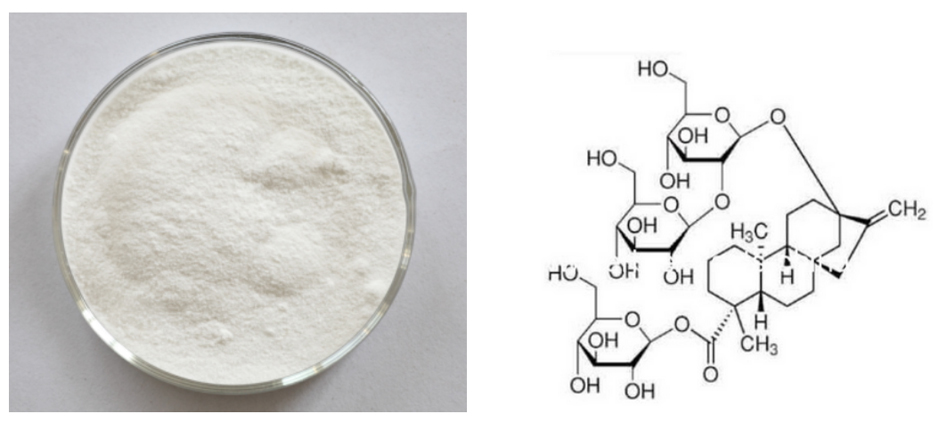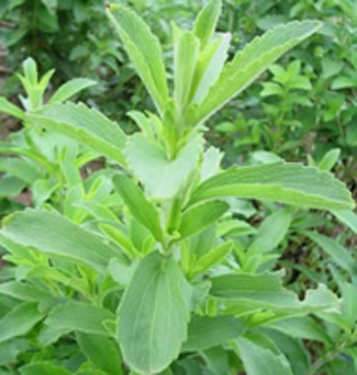12 Years Factory wholesale Stevia Extract Supply to Canada
12 Years Factory wholesale Stevia Extract Supply to Canada Detail:
[Latin Name] Stevia rebaudiana
[Plant Source]from China
[Specifications] 1.Stevia Extract Powder (Steviosides)
Total Steviol Glycosides 80%, 90%, 95%
2. Rebaudioside-A
Rebaudioside-A 40%, 60%, 80%, 90%, 95%, 98%
3. Stevioside 90%
One monomer in Steviol Glycosides
[Appearance] Fine white powder
Plant Part Used:Leaf
[Particle size] 80 Mesh
[Loss on drying] ≤5.0%
[Heavy Metal] ≤10PPM
[Shelf life] 24 Months
[Package] Packed in paper-drums and two plastic-bags inside.
[Net weight] 25kgs/drum
Stevia Extract
[Characteristics]
Stevia sugar features high sweetness and low calorie and its sweetness is 200 350 times of that of cane sugar but its calorie is only 1/300 of that of cane sugar.
The component of stevia extract that gives it its sweetness is a mixture of various steviol glycosides. The components of sweetness in stevia leaves are stevioside, rebaudioside A, C, D, E and dulcoside A. Rebaudioside C, D, E and dulcoside A are small in quantity. The principal components are stevioside and rebaudioside A.
The quality of stevioside and rebaudiosideA is better than those of other components, which are commercially extracted and used in various applications.
The steviol glycosides present in stevia extract are referred to as “steviosides” or ¡°stevia extract¡±. Among these “steviosides”, the most common is Stevioside followed by RebaudiosideA. The Stevioside has a slight and pleasant herbal taste and the Rebaudioside-A has no herbal taste.
Although Rebaudioside C and dulcoside A are small in quantity in stevia extract, they are the major components giving bitter aftertaste.
[Function]
A large number of pharmaceutical tests have proved that stevia sugar has no side effects, carcinogens, and is safe for eating.
Compared with cane sugar, it can save 70% of the cost. With pure white color, pleasing taste and no peculiar smell, Stevia sugar is a new sugar source with broad perspective for development. Stevia rebaudianum sugar is the natural low hotsweet agent mostly similar to the flavor of cane sugar, approved to be used by State Ministry of Health and Ministry of Light Industry.
It is the third natural succedaneum of cane sugar and beet sugar with development and health care value, extracted from the leaves of the herbal vegetable of the composite family-stevia rebaudianum.
Product detail pictures:

Related Product Guide:
All we do is often involved with our tenet " Purchaser to start with, Rely on initially, devoting over the food stuff packaging and environmental defense for 12 Years Factory wholesale Stevia Extract Supply to Canada , The product will supply to all over the world, such as: Montpellier, Angola, Miami, Being guided by customer demands, aiming at improving the efficiency and quality of customer service, we constantly improve products and provide more comprehensive services. We sincerely welcome friends to negotiate business and start cooperation with us. We hope to join hands with friends in different industries to create a brilliant future.
5-HTP… EXPLAINED! | #LMRTV
Many ravers take it, but do they know what it actually is?!
☺RAVEOLUTION
www.raveolutionrecovery.com
www.twitter.com/RaveolutionRX
☺ Subscribe To Me: https://bit.ly/LetMeRaveTV
☺ thumbs up! It helps me know you want more videos ![]()
—————————————-————————————–
☺ My Links:
TWITTER: www.twitter.com/LetMeRave
INSTAGRAM: www.instagram.com/LetMeRave
VINE: @LetMeRave
SOUNDCLOUD: www.soundcloud.com/LetMeRave
SNAPCHAT: ButDatAssDoe
—————————————-————————————–
Make sure you subscribe for more videos!
—————————————-————————————–
☺ Contact: LetMeRave@gmail.com
—————————————-————————————–
Music wanted!!!
If you are a dance music producer and would like me to use your music (deep house/techno vibes) please email me at LetMeRave@gmail.com
—————————————-————————————–
Peace, Love, Techno
Vitamist Men’s Formula – spray vitamin technology. Click now https://www.vitamist.com/?click=L
Call Dr. Noa at 707-718-2036 .2441 Imola Napa 94558
VitaMist Intra-Oral Spray -vs- Pills
Since the 1930′s we all been taking pills to supplement our nutritional needs, to cure a headache or the flu, thus creating a ritual of gulping them down with a glass of water, leaving a chalky taste in your mouth, or even having them get caught in your throat. No matter the size or shape, whether gel caps or coated tablets, it’s not an easy task.
Men’s formula — Vitamist
Men have special nutritional needs that must be addressed daily to ensure optimum health. VitaMist Men’s Formula is synergistically formulated to support the energy, endurance and supreme wellness demands necessitated by the lifestyle today’s man enjoys.
Essential vitamin nutrients in this comprehensive daily supplement include vitamins A, C, D, E, the B-complex vitamins, thiamin, niacin, pantothenic acid, B-6, B-12 and folate, beta-carotene and more. Also, included are herbs that specifically address a man’s needs including saw palmetto (prostate), ginkgo biloba (blood circulation) and the amino acid arginine.
Don’t let the pressures of everyday living weaken you. Help make sure your mind, body, and spirit are operating at peak efficiency by taking VitaMist Men’s Formula every day.
Instructions:
• Shake gently.
• Sprays directly into mouth, 8 spray per day.
• Suggested use – 2 sprays, 4 times a day.
There is now a 21st Century revolutionary way to take your vitamins, minerals and other nutritional supplements – through VitaMist oral spray vitamins. VitaMist oral sprays are the fastest, most effective and convenient way to get a daily dose of vitamins, minerals, herbs and other nutritional supplements. Think about how many people
you know who do not take vitamins simply because they cannot or do not like to swallow pills. That loss could have a negative effect on one’s health.
Through oral spray, nutrients go into the bloodstream and then into the cells within a matter of minutes. In fact, tests from Massachusetts General Hospital have shown
higher blood concentrations of insulin taken by oral application. Even by injection, insulin takes 30 minutes longer to reach the same blood levels. Not only is oral spray more convenient, it also allows those with irritable bowel syndrome, hiatal hernias and diverticulitis to take nutrients that have irritated them in pill, tablet or capsule form.
An Amazing Breakthrough!
As illustrated in the Physician’s Desk Reference. Age is a major factor in absorption; because, as we age, it becomes impossible for the body to have adequate uptake.
Although absorption problems exist in younger people, persons over the age of 35 are more likely to have absorption problems. Unfortunately, as we get older, digestive problems tend to increase, while, at the same time, proper absorption becomes even more important. Age presents a problem that dramatically increases the “odds” against us in the gamble for optimum nutrition.
VitaMist Spray Technology – Breakthrough!
VitaMist intra-oral sprays are patented delivery systems for vitamins, minerals, herbs, amino acids and other supplements. A 55 micro-liter spray delivers high concentrations of nutrients directly onto the mouth’s sensitive tissue called the buccal mucosa and then swallowed. This transfers the nutrients directly into the body.
Men’s Health
Men have special nutritional needs that must be addressed daily to ensure optimum health. VitaMist Men’s Formula is synergistically formulated to support the energy, endurance and supreme wellness demands necessitated by the lifestyle today’s man enjoys.
Essential vitamin nutrients in this comprehensive daily supplement include vitamins A, C, D, E, the B-complex vitamins, thiamin, niacin, pantothenic acid, B-6, B-12 and folate, beta-carotene and more. Also, included are herbs that specifically address a man’s needs including saw palmetto (prostate), ginkgo biloba (blood circulation) and the amino acid arginine.
Don’t let the pressures of everyday living weaken you. Help make sure your mind, body, and spirit are operating at peak efficiency by taking VitaMist Men’s Formula every day.
Instructions:
• Shake gently.
• Sprays directly into mouth, 8 spray per day.
• Suggested use – 2 sprays, 4 times a day.
Ingredients:
More information go to – https://www.vitamist.com/?click=L94513 – or call 707-718-2036
The supplier cooperation attitude is very good, encountered various problems, always willing to cooperate with us, to us as the real God.







